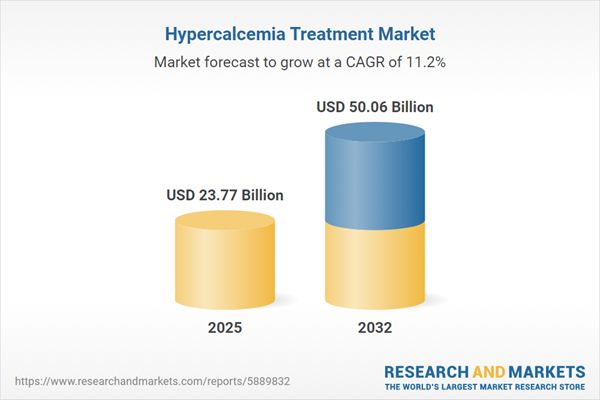Speak directly to the analyst to clarify any post sales queries you may have.
The hypercalcemia treatment market is undergoing significant transformation, shaped by innovation in clinical therapies, evolving risk environments, and a growing focus on strategic foresight among industry leaders. Senior executives must anticipate change, engage with technological progress, and adapt strategies to sustain growth and competitiveness.
Market Snapshot: Hypercalcemia Treatment Market Size and Outlook
The global hypercalcemia treatment market reached USD 21.41 billion in 2024 and is projected to increase to USD 23.77 billion by 2025, with estimates indicating an acceleration to USD 50.06 billion by 2032. This growth, represented by a compound annual growth rate of 11.19%, illustrates strong momentum. Key drivers include progress in precision medicine, advancements in biologic therapies, and ongoing regulatory shifts. Companies are responding with scenario-based strategies while adapting to nuanced regional and segment-specific trends. Leadership that combines innovation with disciplined risk management is critical for long-term organizational value in this evolving environment.
Scope & Segmentation: Strategic Intelligence for Growth
This comprehensive report equips senior leaders with actionable, data-driven insights for confident decision-making regarding market entry, expansion, and innovation across geographies and care models. The segmentation delivers focused intelligence to support operational, clinical, and strategic initiatives:
- Therapy Types: Assessment includes bisphosphonates, calcimimetics, diuretics, and monoclonal antibodies, guiding competitive strategy and research and development focus.
- Routes of Administration: Detailed review of intravenous, oral, and subcutaneous delivery accommodates a range of provider and patient requirements.
- End Users: Segmentation supports targeting strategies for surgical centers, clinics, hospitals, and home healthcare, enhancing positioning and alignment across diverse provider channels.
- Patient Groups: Insight addresses product design and communications for adults, geriatric, and pediatric populations, supporting tailored solutions and engagement strategies.
- Distribution Channels: Examination of hospital, retail, and online pharmacies informs procurement optimization and supply chain resilience in various medical settings.
- Regions: The report delivers actionable regional intelligence for the Americas, Europe, Middle East and Africa, and Asia-Pacific, underscoring the necessity of local market adaptation within a cohesive global approach.
- Technologies & Care Models: Coverage includes digital health platforms, telemedicine, infusion services, and biomarker-based tools to reveal advanced pathways for patient engagement and operational efficiency.
- Key Companies Tracked: Benchmarking is provided for Novartis AG, Amgen Inc., Teva Pharmaceutical Industries Ltd, Viatris Inc., Sandoz, Fresenius Kabi AG, Dr. Reddy’s, Sun Pharmaceutical, Lupin Ltd, and Pfizer Inc., supporting strategic positioning and market reference exercises.
Robust segmentation supports scenario planning and targeted investments, helping organizations mitigate market volatility and align with overarching strategic priorities.
Key Takeaways for Senior Decision-Makers
- Advanced diagnostic and individualized risk assessment tools are shaping patient pathways and improving the quality of clinical decision-making across care settings.
- Digitization, including telemedicine and connected health ecosystems, is increasing accessibility and improving operational workflows for healthcare providers and patients.
- Collaboration among clinical, commercial, and technology experts is expanding the adoption of new therapies and fostering care models centered around measurable patient outcomes.
- Shifting reimbursement models are prompting investments that prioritize sustainable impact, encouraging cooperation across the care continuum and stakeholder groups.
- Rising competition from generics and biosimilars is prompting continuous improvements in procurement strategies and logistics planning to enhance cost-effectiveness.
- Adaptable patient adherence and support initiatives are facilitating compliance with evolving regulatory obligations and dynamic standards of care.
Tariff Impact: Navigating U.S. Adjustments and Global Supply Chain Shifts
Upcoming U.S. tariff changes are compelling real-time reassessment of procurement strategies, with a growing need to evaluate domestic production as a risk mitigation measure. Organizations must sustain engagement with regulatory authorities and payers while adapting quickly to changes across global supply chains, ensuring operational consistency and competitive standing across divisions.
Methodology & Data Sources
The report integrates insights drawn from direct interviews with clinicians, pharmacy leaders, and payers, supplemented by patient survey data. All findings are validated against current regulatory standards and independently reviewed for strategic accuracy and reliability.
Why This Report Matters for Senior Leaders
- Enables senior leaders to identify, track, and leverage technological shifts, therapeutic advancements, and changes in market regulation in the hypercalcemia treatment sector.
- Provides segmented, data-backed analysis to support timely decisions regarding market entry, capacity building, and resource allocation, ensuring alignment with strategic goals.
- Strengthens organizational approaches to supply chain management and go-to-market initiatives as sector innovation continues at pace.
Conclusion
This report offers a strategic platform for achieving agility, driving innovation, and pursuing sustainable success. Senior leaders are empowered to navigate upcoming challenges and capitalize on new opportunities as the hypercalcemia treatment market continues to transform.
Additional Product Information:
- Purchase of this report includes 1 year online access with quarterly updates.
- This report can be updated on request. Please contact our Customer Experience team using the Ask a Question widget on our website.
Table of Contents
3. Executive Summary
4. Market Overview
7. Cumulative Impact of Artificial Intelligence 2025
Companies Mentioned
The companies profiled in this Hypercalcemia Treatment market report include:- Novartis AG
- Amgen Inc.
- Teva Pharmaceutical Industries Ltd
- Viatris Inc.
- Sandoz International GmbH
- Fresenius Kabi AG
- Dr. Reddy’s Laboratories Ltd
- Sun Pharmaceutical Industries Ltd
- Lupin Ltd
- Pfizer Inc.
Table Information
| Report Attribute | Details |
|---|---|
| No. of Pages | 183 |
| Published | October 2025 |
| Forecast Period | 2025 - 2032 |
| Estimated Market Value ( USD | $ 23.77 Billion |
| Forecasted Market Value ( USD | $ 50.06 Billion |
| Compound Annual Growth Rate | 11.1% |
| Regions Covered | Global |
| No. of Companies Mentioned | 11 |









